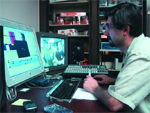Five years ago, facilities that were editing TV series in high definition were not only future-proofing the product but were also preparing for their own futures. Now that the future has arrived, they're sitting pretty, having gradually evolved their HD facilities along with the evolution of actual HD broadcasts.
CBS was the first network to embrace HDTV, ABC was the next to follow and now NBC has joined the fold. The WB Network will also be airing some series in HD this coming season, as will some of the cablenets. The Fox Network is testing the waters with pilots and expects to be heavily into HD for the '04-'05 season. For the most part, the series remaining in standard definition among the networks are long-running shows, such as Friends, that are going into their final season.

DigitalFilm Tree's Edvin Mehrabyan onlines Scrubs on a Final Cut Pro system equipped with an AJA IO card for HD.
|
SCRUBS FOR HD BROADCAST?
For HD delivery, a big holdout among the top 10 shows was Scrubs, a Touchstone Television and NBC co-production. Last season, it was shooting on Super 16mm and delivering on Digital Betacam, according to Ramy Katrib, CEO of DigitalFilm Tree (www.digitalfilmtree.com) in Los Angeles. This season, the program is still being shot in Super 16, but NBC is seriously considering broadcast in HD. DigitalFilm Tree does the online editing of the series, while Level 3 Post in Burbank transfers it to HDCAM and handles color correction and delivery of dubs.
"Most shows are under pressure to have an HD master, no matter what they're showing," Katrib notes. "Once they finish in HD, they can repurpose for standard definition, HD or PAL delivery."
His operation recently acquired a Sony HDCAM deck, and it is experimenting with the Sony Xpri, a nonlinear editing system that handles standard definition while being a native HD editing system.
"We're interested in what we've seen over the past month," reports Katrib. "Our editors have been giving feedback to Sony and we hope it becomes a workable system for our post services." He notes that a native editing system can best exploit the advantages of Sony's HDCAM.
"One of the biggest challenges now," he adds, "is finding a good workflow for offlining HD. It takes up a lot of space on a hard drive." His facility is designing an individual path for each client, tailored to its needs. For Scrubs they are using systems like Apple's Final Cut Pro powered the AJA PCI capture card, the IO, which allows working in HD. Apple's Shake software is used in conjunction with Final Cut Pro for compositing on the series.
"Once we digitize the HD content," Katrib explains, "we can do such processes as color correction, titling, image manipulation and 2D and 3D content all at the same location."
FILM TO HD TRANSFER, HD POST
Along with its work on Scrubs, Level 3 Post (www.level3post.com), is also posting Third Watch, West Wing and Wanda At Large in HD. According to Darrell Anderson, managing director, this work has extended to pilots, such as Las Vegas, for NBC. Only a couple of years ago, much of the HD work was in anticipation of airing in that format, he says. Now nearly everything shot in 24p, or in film for HD transfer, is for immediate airing in HD. One exception, he notes, is the FX program Lucky, which is downconverted from HD to standard after the assembly session.

Level 3 intends to use its new Cintel C-Reality to transfer film to HD tape for episodics like The West Wing.
|
"At the end of last season," Anderson recalls, "we discussed what the future might bring and acquired a Cintel C-Reality to transfer film to tape in HD. It will certainly be used for Third Watch and West Wing, and probably for Wanda At Large. We're also buying some additional HDCAM machines to handle shows shot in 24p."
Meanwhile, the facility was installing two Avid Nitris systems which double its HD editing capabilities. They'll be used for assembly, compositing, titling, film repair and paint work. Each of the Nitris systems will have 1.5 terabytes of storage. And if that isn't enough, sister company Digital Symphony always has extra storage space available.
ENCORE's Working on 16 SERIES in HD
At Encore Hollywood (www.encorehollywood.com), some 16 series are being posted in HD, compared with only three or four in standard. HD clients include established series such as Boomtown, Alias, Without a Trace and Monk, as well as new series like ABC's Line of Fire and CBS's Navy NCIS. Managing director Jackie Peretti notes that the general rule is for half-hour series to shoot in 24p and for one-hour programs to transfer from film. But she notes that some of the dramatic series are now starting to discuss shooting in 24p.

What every HD post client needs to know
|
The process of gearing up for the increased HD effort has been assisted by the consolidation into Encore of Hollywood Digital, sister company in the Ascent Media Group. Along with talent, it brought in a Thomson Spirit telecine and Discreet Fire and Inferno equipment. Between the inherited equipment and purchases, Encore now has two Fires and four Infernos. Meanwhile, it has purchased a da Vinci 2K color corrector.
Quadrupling the number of HD shows handled over the past few years has been a gradual process for Encore, so no drastic changes have been necessary in workflow procedures. Additional storage space has been required to handle the vast requirements of special effects in HD.

We have your music cartoon
|
MAKING THE MOVE TO HARD DISK
Emory Cohen, president/COO of Hollywood's LaserPacific (www.laserpacific.com), which was recently purchased by Kodak, estimates having 30 series for this season, three-quarters of which are HD. Some of the holdouts are Fox series, while others are WB or UPN series that will remain SD. But LaserPacific will be doing two WB series, The Gilmore Girls and Everwood, in HD.
In 1998, LaserPacific was doing 60 percent of CBS's HD work, which amounted to eight series. That required a substantial initial investment, Cohen reports, but as the company became one of the first to go all the way from telecine to distribution in HD, the financial burden eased up. "We've designed our plant to scale up without having to replicate the system each time," he explains. "We still have to keep a standard definition plant current. If we let our standard definition services slide, those customers would be going somewhere else."
This season, the facility is making a major move to hard-disk-based technology, using a custom system in which QuVis' QuBit plays a major role. As a wavelet-based, resolution-independent hard disk system, Cohen says, it's the quality equivalent of the best tape machines. This offers the advantage of not having to buy different kinds of tape machines as well as the random access speed benefits.
In archive storage, he adds, tape is still efficient, but the hard disk system uses removable hard drives, offering the best of both worlds in disk vs. tape storage.
Cohen has seen some movement toward shooting hour-long HD series in 24p, but notes that it hasn't been consistent. Last season, the facility was handling five dramas shot on 24p and this season there is only one. The difference is represented by cancelled series, not a return to film.
"At least for now," he concludes, "it doesn't look like film is on its way out. "Film is still more cinematic, and the camera and lens combination gives the DP better control over depth of field. The crew is more comfortable in film, in such areas as handling makeup for film. The best reason for shooting in tape is money, but the savings in dramas, as a portion of the budget, are not as great as people thought they would be. Savings are more predictable in the set-based environment of a sitcom. In a drama, many issues, such as lighting, vary from episode to episode and there are offsetting expenses."
ALL GEARED UP
LA's Modern VideoFilm (www. mvfinc. com) is starting its fifth season in HD, according to president Moshe Barkat. It was initially editing TV shows and mastering feature films in HD to a much smaller extent. The first major transition occurred on the mastering side nearly three years ago, when it completed conversion to HD mastering. It is now into 2K scanning and mastering, bringing major studios into a wide range of media.
In editing, Modern has geared up as TV series have moved into HD. Jon Johnson, executive VP of sales, says 70 to 80 percent of TV clients are now in HD. "In the next couple of years, I'd be surprised to see any shows left in standard definition," he adds. Among the HD shows being handled by the operation are Everybody Loves Raymond, The American Family, Six Feet Under, Strong Medicine and The Division.
With the first edit suite converted to HD five years ago, Modern now is moving to five HD bays and three in standard. It recently added a second Sony linear HD bay and was installing a resolution-independent Quantel nonlinear iQ room and two Avid|DS HD suites. Two additional iQ editing systems are part of the mastering operation.
Clients who are experienced in the post process are having an easy time making the transition to posting in HD, Barkat says, but it's a more difficult change for the post facility. He says it's not just a matter of adding the editing equipment, but the infrastructure can be equally expensive. Routing and distribution systems, monitors and test equipment all have to make the transition to HD, he notes.